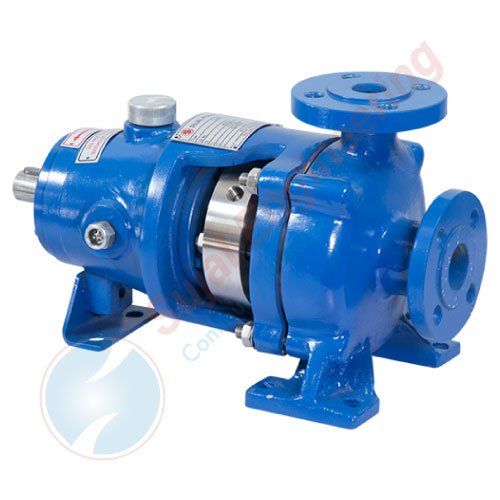How to Calculate Industrial Pump Flow Rate?

Introduction
Knowing the flow rate of your industrial pump is crucial. As having knowledge of the pump flow rate helps assess if an existing pump is working properly, and determine the accurate setup you will need to transfer the volume of liquid.
In this blog, we will determine the pump flow rate calculation and various factors affecting the flow rate of industrial pumps.
What Is The Pump Flow Rate?
The pump flow rate is the volume of liquid moving through an industrial pump in a given time period. Multiple units are measured while calculating the flow rate of a pump.
Various units measured include cubic meter/hour (m3/h), liter/sec (l/s), or gallons per minute (GPM).
What Are The Factors That Affect Pump Flow Rate?
1. Impeller Design:
Impeller design parameters significantly influence the flow rate. Factors such as the number of blades, blade angle, and impeller diameter impact the pump’s performance and ability to generate the desired flow rate.
2. Pump Speed and Impeller Diameter:
The rotational speed of the pump and impeller diameter are directly related to the flow rate. Higher pump speeds and larger impeller diameters commonly result in higher flow rates. The number of times the pump can complete an entire cycle in a minute is also considered.
3. Resistance and Head Loss:
The resistance offered by the system creates a head loss, which can lead to a decrease in the flow rate. Hence, understanding the system’s hydraulic characteristics and reducing head losses are vital in order to achieve the desired flow rate.
4. Fluid Viscosity:
The viscosity of the fluid being pumped also affects the flow rate. For transferring higher viscous fluids it requires more power to achieve the desired flow rate due to higher friction loss.
5. Cavitation and NPSH:
Cavitation adversely affects the flow rate and pump performance. Hene, Net Positive Suction Head (NPSH) is critical for preventing cavitation and ensuring optimal flow rates. Insufficient NPSH can lead to decreased flow rates and can cause damage to the pump.
6. Pump Size:
Larger pumps can move more liquid compared to the smaller ones. Hence, the size of the pump can significantly affect the flow rate, making it crucial to select the appropriate size pump.
7. Liquid Density:
Heavier liquids flow more slowly than lighter liquids due to higher energy requirements. Lower-density liquids in the same place will require less energy and result in higher flow rates.
8. Pipe Size, Pipe Length, and Pipe Bends:
Larger pipe diameters, shorter pipe lengths, and fewer pipe bends result in higher flow rates due to reduced resistance.
How To Calculate The Flow Rate Of Pump?
To calculate the industrial pump flow rate, you must have the following details with you:
- Pump speed
- Pump’s impeller size
- Fluid density
Only when you have this information you will be able to calculate the flow rate of the industrial pump.
Pump Flow Rate Calculation:
Flow Rate = Pump Speed x Impeller Size x Fluid Density
The speed of the pump is expressed in revolutions per minute (rpm). To convert rpm to hertz, divide by 60. For instance, if a pump runs at 1200 rpm, its frequency would be 20 Hz.
The impeller size is specified in inches. For example, a typical impeller size is 8 inches.
Fluid density is given in pounds per cubic foot (lb/ft3). For instance, oil has a density of 50 lb/ft3
Suppose we have a pump operating at 1200 rpm, with an impeller size of 8 inches, and pumping oil with a density of 50 lb/ft3. In this case, the flow rate would be:
Flow Rate = 1200 rpm x 8 inches x 50 lb/ft3
Flow Rate = 480,000 lb/ft3 per minute
To convert from pounds per minute to gallons per minute, divide by 7.5. Hence, the flow rate in this scenario would be:
Flow Rate = 480,000 lb/ft3 per minute / 7.5
Flow Rate = 64,000 gallons per minute
To convert from gallons per minute to cubic meters per hour, you need to multiply by 0.2271. Therefore, the final flow rate in this example would be:
Flow Rate = 64,000 gallons per minute x 0.2271
Flow Rate = 14,508.4 cubic meters per hour
How To Improve The Efficiency Of Pump Flow Rate?
Choose The Right Pump:
To increase the flow rate efficiency in pumps, choose the right pump for your application. Ensure the pump type and technical specifications are appropriate for the application requirement.
Material Selection:
Choosing a pump manufactured using the right material is vital. To give an example, if your application requires handling corrosive fluid, opt for a pump made of stainless steel or other corrosion-resistant materials.
Select The Correct Size:
The next important thing to consider for a high flow rate is pump size. The pump size should be neither too small for the application nor too large, as an improper pump size will not operate at peak efficiency.
Regular Maintenance:
Frequent maintenance plays an important role in improving the pump efficiency and flow rate. Regular inspection, cleaning, and maintenance make sure the pump components are operating properly.
Bottom Line
For efficient pump operation, it is necessary to understand the pump flow rate and check if your pump is achieving the desired flow rate.
It’s always advisable to choose a trusted pump manufacturer in India to ensure the pump you choose is well suited for your application requirements.
Sujal Engineering is a leading manufacturer and supplier of industrial pumps in India. We provide a high-quality pump range coupled with superior customer service to exceed customer expectations.
Get in touch with our team to find the best industrial pumps for your application needs.





